Robot Assisted Prostatectomy
Robot Assisted Prostatectomy for Prostate Cancer
At the Cancer Center at BIDMC, prostate cancer patients are cared for by a multidisciplinary team of prostate cancer specialists. These specialists include medical oncologists, radiation oncologist and surgeons, among others. We see most patients within a week, and deliver diagnoses and treatments promptly.
If a patient and his doctors decide that surgery is the best choice for his cancer, he may be a candidate for a robot-assisted prostatectomy. This is a minimally invasive approach to the traditional "open" prostatectomy. In the past, prostatectomy was accomplished with open surgery, that is, through a 5- to 8-inch incision in the lower abdomen. Advances in minimally invasive technology today provide patients with a less invasive surgical alternative. Excellent cure rates are the result, with fewer potential complications like blood loss, protracted pain, infection, transfusions and extended hospital stays.
National Leader in Robotic Surgery for Prostate Cancer
Studies have shown that high-volume centers produce the best surgical outcomes. Our Prostate Cancer Program is Boston’s foremost center of robotic surgery for prostate cancer, with two fellowship-trained surgeons who have performed more than 2,000 minimally invasive procedures. The BIDMC Cancer Center is a national leader in the use of this approach for prostate cancer surgery. We are the only New England institution that offers a training course to other urologic surgeons in robotic prostate cancer surgery.
We invite interested patients and their doctors to contact our center for more information. Our surgeons have received advanced training and are considered experts in prostate cancer care. They have performed hundreds of prostatectomies and have authored numerous publications. Most patients are seen and evaluated within one week.
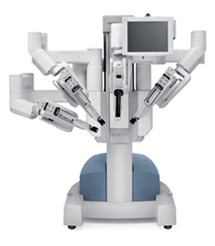
The da Vinci Surgical system--the "robot"--provides surgeons with an alternative to both traditional open surgery and conventional laparoscopy by putting a surgeon's hands at the controls of a state-of-the-art robot. The da Vinci system enables surgeons to perform exceedingly complex and delicate procedures through very small incisions.
Benefits for the patient may include:
- Less pain
- Significantly less blood loss
- Less scarring
- Shorter recovery time
- A faster return to normal, daily activities
Da Vinci® Prostatectomy
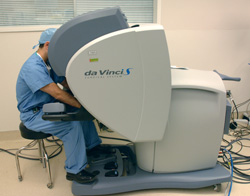
At BIDMC, we understand that facing any kind of urologic surgery can create tremendous anxiety. You may wonder if your body will function normally after surgery. Traditional open urologic surgery — in which large incisions are made to access the pelvic organs — has been the standard approach when surgery is warranted. Drawbacks of this procedure include large blood loss, significant post-surgical pain, lengthy recovery time and an unpredictable, potentially long-term impact on continence and sexual function.
The robotic-assisted, minimally invasive prostatectomy procedure allows a surgeon to operate using the most advanced techniques. Seated at at the console, the surgeon is able to view a true-to-life 3-D image of the prostate and surrounding organs, which provides greater surgical precision, dexterity and control than standard laparoscopic surgery. and makes it possible to perform the operation through one centimeter incisions. This dexterity is particularly valuable required for the delicate and precise suturing and reconstruction. Our studies have shown that robotic prostatectomy is able to remove the cancer at least as well as open surgery. Also, we are able to spare muscles and nerves, important for continence and sexual function, at least as well as during open surgery and at the same time give patients the benefits of minimally invasive surgery.
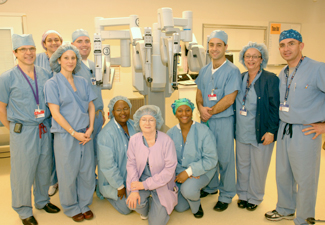
Our experienced and dedicated urologic robotic surgery team provide the highest level of care beginning in the pre-operative waiting area, during the surgical procedure to the recovery room. A clinical nurse advisor oversees all aspects of patient care during their robotic surgery. The team also includes five registered nurses and three surgical technicians. Together they have decades of operating room experience and work in synergistic harmony through each step of the process.
With the aid of magnified, high definition, 3-D images of the prostate and surrounding anatomy, robot-assisted laparoscopic radical prostatectomy typically takes three to four hours. The surgeon performs the delicate dissection and is able to control the surgical instruments using the robotic console. BIDMC robotic surgeons are fellowship trained, have years of minimally invasive surgical experience and have performed hundreds of surgeries for prostate cancer, including open, laparoscopic and robotic surgeries.
Once the prostate is separated from surrounding tissue, it is placed in a small bag and removed through one of the incisions, which is extended to about 2-3 centimeters. The bladder and urethra are then sutured back together; this is referred to as the urethral-bladder anastomosis (figure below). Nerve sparing surgery, when appropriate, and lymph node dissection are often performed using this approach as well.
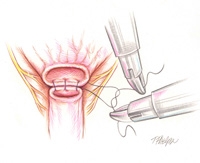
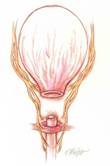 The neurovascular bundles, responsible for controlling erections, run on either side of the prostate. These bundles may be spared during the surgery, thereby allowing sexual function to recover in some men. Younger men who are sexually active with good function prior to surgery generally tend to benefit from nerve preservation. Older men who have some sexual dysfunction prior to surgery are less likely to benefit. In some instances, preservation of the neurovascular bundle may not be possible due to the location or extent of the cancer or due to scar tissue around the prostate. Please discuss the risks and benefits of a nerve sparing procedure with your surgeon.
The neurovascular bundles, responsible for controlling erections, run on either side of the prostate. These bundles may be spared during the surgery, thereby allowing sexual function to recover in some men. Younger men who are sexually active with good function prior to surgery generally tend to benefit from nerve preservation. Older men who have some sexual dysfunction prior to surgery are less likely to benefit. In some instances, preservation of the neurovascular bundle may not be possible due to the location or extent of the cancer or due to scar tissue around the prostate. Please discuss the risks and benefits of a nerve sparing procedure with your surgeon.
Urinary continence tends to return within three to six months after surgery. Sexual function returns more gradually in those who have undergone nerve-sparing radical prostatectomy, often one to two years or longer. Return of erections may be facilitated by early use of Viagra, Cialis or Levitra, or a penile vacuum pump. Other more invasive options are available further along in your recovery, such as penile injections. You should discuss these and other options with your surgeon.
Choosing surgery to remove the prostate is one of several options for men with prostate cancer who appear to have localized disease -- that is, cancer confined to the prostate. It allows, in most cases, for complete removal of the cancer. Once the prostate has been removed, we can determine how advanced the cancer is, what the risk for cancer recurrence is and whether or not additional treatment may be necessary. Additional treatments are available, if needed after surgery, through our comprehensive Prostate Cancer Program.
Patient's Guide to Prostate Cancer Surgery at BIDMC
Pre-operative Testing
Before surgery, you will need to undergo a number of tests to determine the extent of your disease and your overall physical health. These tests include blood tests, urine tests, chest x-ray (CXR), and electrocardiogram (EKG). In selected patients, a bone scan, an abdominal/pelvic computed tomography (CT) scan or a prostate MRI may be performed at a different time. Your medications will be reviewed with you and you will be advised as to which ones you can and cannot take prior to surgery. You will also meet with an anesthesiology team member in order to discuss your health history and discuss the general anesthesia that you will receive. This visit will be arranged by your surgeon's office and is usually scheduled one week prior to surgery. Pre-op testing is located on the West Campus at1 Deaconess Rd , Clinical Center, 3rd floor.
The day before surgery you will begin a bowel preparation at home. This is done in order to cleanse the bowel and consists of a medication called Magnesium Citrate. You will drink one 10 oz. bottle. On this day you may only drink clear liquids, no solid food is allowed. You will receive a letter with detailed instructions as to when and how to take this medication. This is a routine preparation before many types of major abdominal surgery. You must stop all food and fluid intake by midnight the night before your surgery. On the day of your surgery you will be admitted to the hospital through the Feldberg Building on the East Campus at 330 Brookline Ave .
Clear liquid diet:
- Water
- Clear Broths (no cream soups, meat, noodles etc.)
- Chicken broth
- Beef broth
- Vegetable broth
- Juices (no orange juice or tomato juice)
- Apple juice or apple cider
- Grape juice
- Cranberry juice
- Lemonade
- Kool Aid
- Gator Aid
- Propel
- Tea (you may add sweetener, but no cream or milk)
- Coffee (you may add sweetener, but no cream or milk)
- Clear Jello (without fruit)
- Popsicles (without fruit or cream)
Recovery
After surgery, you will be brought to the recovery area and monitored as you wake from anesthesia. Recovery is typically 2-3 hours long and you are then brought to 12 Reisman where our urology patients are cared for. You will have IV pain medication through a pump the first night, which you control; this is patient controlled analgesia (PCA). You will be allowed to walk the night of your surgery, if possible, and will be allowed sips of clear liquids. The day after surgery you will be placed on oral pain medication and will need to walk 4-6 times. You will have a drain in place from surgery which is usually removed the day you are discharged. You will be taught to care for your foley catheter, which will stay in place for 7-10 days, and will be removed in our urology office as an outpatient.
Most men are able to go home from the hospital in the afternoon the day after surgery. In order to be discharged you must be able to tolerate liquids and minimal foods, have good pain control with oral pain medication, and are able to ambulate on your own.
Prescriptions
You will be given three prescriptions at discharge: Vicodin, Colace and Ciprofloxacin. Vicodin is for pain (to be taken when regular Tylenol or ibuprofen are not working). Do not take the Vicodin with Tylenol. Colace is a stool softener and can also be obtained as an over the counter medicine. Ciprofloxacin is an antibiotic which you should start taking the day before your catheter removal and continue for three days.
Diet
Constipation is a common side-effect of narcotic pain medication such as Vicodin. You may eat and drink what ever you wish, but should adjust your diet so that you avoid constipation, until your normal bowel function returns (this can take up to 3-5 days). Foods to avoid include bananas, pasta, rice, bread, and cheese. Eating small meals throughout the day is preferable. Taking colace, increasing your fluid intake and prune juice may help with this. If you do become constipated you may also take Milk of Magnesia which can be obtained as an over the counter medicine. Do not use an enema or suppository for the first three months after surgery, your rectal wall is very thin and you may injure yourself. Alcohol consumption in moderation is acceptable as long as you are not taking pain medication.
Ambulation
After you are discharged from the hospital, you can take long walks and go up and down stairs. However, you must avoid lifting more than 15 pounds and exercising vigorously (calisthenics, golf, tennis) for a total of three weeks from the day of surgery. It takes at least three weeks for firm scar tissue to develop in both your wound and in the areas where you underwent surgery. During the first three weeks you are at home do not sit upright in a firm chair for more than one hour. We prefer having you sit in a semi-recumbent position (in a reclining chair, on a sofa, or in a comfortable chair with a foot stool). This accomplishes two goals: 1) it elevates your legs, thereby improving drainage from the veins in your legs which will reduce the possibility of a clot formation (see below); and 2) it avoids placing weight on the area of your surgery in the perineum (the space between the scrotum and the rectum.) There are no other serious restrictions. Three weeks following surgery you may resume all the same activities you were enjoying before surgery.
Pain Control
One of the advantages of robotic surgery is a reduction in postoperative pain. Nevertheless you will still experience some pain and discomfort for at least a week or two after surgery. This can be from the incisions as well as the catheter. For most patients, over the counter medicine is all that is needed. This can be ibuprofen (600mg every 6 hours as needed with meals) or extra strength Tylenol (1000mg every six hours as needed, not to exceed 4000mg in 24 hours). You will still get a prescription for stronger narcotic pain medicine on discharge, which you should take if the other medicine does not work. Do not take this medicine with Tylenol. Most patients are pain-free by 3-4 weeks. KY Jelly can be used on the tip of the penis and catheter where it enters the penis to decrease friction and discomfort with increased activity.
Catheter Removal
Your catheter is usually removed 7-10 days from the day of surgery. One day prior to catheter removal, begin taking Ciprofloxacin and continue for three days. On the day you are going to have your catheter removed drink a lot of fluids before you arrive at the office. On that day we are only concerned with whether or not you are urinating with a strong stream. The recovery of urinary control takes longer (you will receive additional information about urinary function at your one week follow-up visit).
Return to Work
Most patients who do sedentary "office" activities can return to work gradually two weeks after surgery. Your energy level and appetite will be low so don't push it! If you do strenuous work (e.g. lifting, on you feet all day) you will need to wait at least three weeks. For those of you who travel a lot you should also wait at least three weeks. You can begin to drive three weeks from the surgical date.
Problems after Prostatectomy
Bleeding - It is not uncommon to have a bloody discharge around the catheter when you strain to have a bowel movement; do not become concerned; it will stop. Also, do not worry about some blood in the urine; it may arise from vigorous walking; the ingestion of aspirin or Motrin, or it may occur spontaneously. If this occurs, force fluids. This will dilute out the blood so that it does not clot off the catheter and will encourage the cessation of bleeding. Blood in the urine usually has no significance and spontaneously resolves on its own, usually by the time the catheter is removed. A large amount of bright red blood is unusual and you should call the doctor immediately.
Catheter - Leakage around the catheter is very common, especially when you're walking around or having a bowel movement. If your catheter stops draining completely, lie down flat and drink a lot of water. If after 1 hour there is no urine coming through the catheter it is possible that your catheter has become obstructed or dislodged. At this point call us. Also, the passage of small blood clots after catheter removal is normal and of no concern unless it is persistent.
Wound - You can take a shower immediately after you return home. You might have steri-strips over your incisions and they will fall off spontaneously on their own, do not pull them off. It is also normal to feel a firm ridge under your incisions. Over the next 6-12 months the incisions will fade and smooth out. Avoid hot tubs and baths for one week.
Clots - During the first 4-6 weeks after surgery, one major complication that occurs in 1-2% of men is a clot in a vein deep in your leg (deep venous thrombosis). This can produce pain in your calf or swelling in your ankle or leg. These clots may break loose and travel to the lung producing a life threatening condition known as pulmonary embolus. A pulmonary embolus can occur without any pain or swelling in your leg; the symptoms are chest pain (especially when you take a deep breath), shortness of breath, the sudden onset of weakness or fainting and/or coughing up blood. If you develop any of these symptoms or pain/swelling in your leg, call your surgeon or the covering physician. Also, you should immediately call your local physician or go to an emergency room.
Urinary Tract Infection - Urinary tract infections are not uncommon following catheter drainage. They can be manifested in several ways. Before the catheter is removed the urine may become permanently cloudy or you may develop some purulent drainage around the catheter. This suggests that you have a urinary tract infection. Please call us and we will prescribe an antibiotic. You will be given an antibiotic to take starting the day prior to catheter removal, the day of, and one day after. It is common to have some burning and irritation around the penis after the catheter is removed for several days and this does not mean you have a urinary tract infection. The burning should gradually subside. It may also help to keep the tip of your penis and catheter (where it enters the penis) clean at all times. Use warm water and soap to remove dried blood or drainage that may accumulate there.
Swelling The scrotum and penis may become swollen. If so, lie down, lift the scrotum and penis up (to do this it may be necessary to unhook the catheter), and place a terry cloth towel between your legs to maintain the elevation of the scrotum. The swelling should decrease within 12-24 hours.
Bladder spasm -While the catheter is in place, it is not unusual to have a strong sudden desire to urinate with pain over the bladder area and simultaneous leakage of urine or blood around the catheter. This is called a bladder spasm and commonly occurs at the time of bowel movement. If it occurs you should lie down until the discomfort passes. If these become frequent and bothersome, call our office and we can prescribe a medicine to help relax the bladder (ditropan, side effects include constipation, dry mouth, and possibly, altered mental status. Patients with glaucoma cannot take this). Ibuprofen can also be used to help with the spasms. You must stop taking Ditropan, at least 24 hours prior to having your catheter removed.
Fatigue - Remember, you will not have your normal strength, appetite, and energy for several weeks after surgery so use common sense when you return to your pre-surgery activity. Activities that seemed effortless prior to surgery will bring on fatigue more quickly and you will need to rest some during the day. Please do not be discouraged!
Long-term Evaluation
Once we have had our first office visit to remove the catheter we will continue to meet at three-four month intervals, for the first year following surgery. You should obtain your PSA for when we meet at each visit following surgery. Therefore please obtain this either through the BIDMC lab or through a lab near your home. Thereafter you will need to have a PSA on a regular basis (every 6-12 months). We would like to receive these reports at regular intervals so that we can follow your progress.
You may also be asked to participate in studies, such as our long term assessments of quality of life or contribute to our tissue banking studies. Tissue banking of your cancer allows researchers at BIDMC to evaluate better ways to find and cure cancer. Quality of life studies are extremely important and requires a small portion of your time but gives us a tremendous amount of feedback regarding your overall recovery, as well as your urinary and sexual function. Please take the time to answers these questionnaires honestly and accurately. With this data we can further refine our surgical technique and postoperative care to make the process even easier for future generations. Please feel free to make suggestions along the way about how we can improve any aspects of your care.
